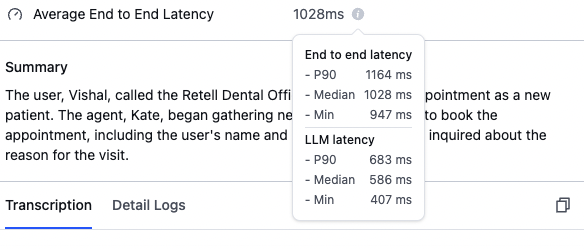Mastering Voice AI Latency: The Agency's Guide to Lightning-Fast Conversations
Stop lagging behind.
When it comes to Voice AI, latency is not a minor technicality. It is the barrier between seamless conversations and a frustrating user experience. At Waboom.ai, we’ve deployed voice agents at scale. We’ve tuned, tested, and rebuilt entire stacks to shave milliseconds off call times.
Here’s what actually works when building high-performance voice agents on Retell’s AI
Understanding the Latency Chain
Voice AI latency comes from multiple sources in the conversation pipeline. Each component adds delay, and understanding these sources is crucial for optimisation:
The Complete Latency Stack:
Network RTT: Round-trip time between user and servers
Speech-to-Text (STT): Converting voice to text
LLM Processing: Your language model generating responses
Text-to-Speech (TTS): Converting text back to voice
Knowledge Base Retrieval: Database lookups (when enabled)
Function Calls: External API calls and tool executions
The Biggest Latency Culprits
1. LLM Response Time (500-900ms normal range)
Your LLM is often the bottleneck. When consistently above 900ms:
Use Fast Tier: Retell's dedicated resource pool ensures consistent latency at 1.5x cost
Switch providers: Some LLM providers have better infrastructure
Optimize prompts: Shorter, more focused prompts reduce processing time
Stream responses: Always stream rather than sending complete responses
2. Knowledge Base Queries (~100ms impact)
While optimized for real-time use, knowledge base retrieval adds latency:
Limit knowledge bases: Only attach essential ones to agents
Optimize content structure: Use markdown with clear paragraphs
Group related information: Better chunking improves retrieval speed
3. Function Calling Overhead
Each tool call adds processing time:
Minimize function complexity: Keep tool definitions simple
Use background execution: For non-critical functions
Batch operations: Combine multiple actions when possible
4. Voicemail Detection (~100ms impact)
While optimized, voicemail detection adds some latency:
Disable if unnecessary: Only enable for outbound campaigns
Optimize timeout settings: Reduce detection window when possible
Technical optimisation Strategies
// Optimal settings for low latency
const option = {
temperature: 0.3, // Lower = more consistent, faster
maxTokens: 150, // Shorter responses = faster generation
frequencyPenalty: 1, // Reduce repetition
stream: true // Always stream responses
};
Response Streaming Best Practices
Stream immediately: Don't wait for complete responses
Handle interruptions: Stop processing older requests when new ones arrive
Optimise first token time: This impacts perceived latency most
# Efficient response handling
async def stream_response(request):
for chunk in llm_stream:
if request['response_id'] < current_response_id:
return # Abandon outdated responses
await websocket.send_text(json.dumps(chunk))
Tailoring Speed by Industry (With Examples)
Healthcare & Telemedicine
Prioritise precision over speed:
Structure LLM responses like:
“Patient requires 2x 5mg amlodipine daily for hypertension.”
Not:
“The patient should maybe consider taking something for high blood pressure.”Run LLM fallbacks to avoid outages:
If OpenAI is slow or down, auto-route to a Claude or Mistral backup model mid-call without alerting the user.Tune privacy and compliance without killing performance:
Strip personal identifiers at the API gateway before forwarding to the LLM. Keep PHI/PII token-safe without slowing downstream calls.
Financial Services
Use Fast Tier for regulated conversations:
In a balance inquiry or mortgage pre-approval scenario, Fast Tier reduces LLM delays during high-friction compliance checks.Preload account data to reduce mid-call lookups:
Before greeting the user, inject a JSON object with pre-fetched account balance, transaction history, and status flags.Deploy regionally to cut routing times:
For APAC users, route LLM traffic to Sydney or Singapore instead of using US-based endpoints.
E-commerce & Sales
Cache product info so the agent isn’t always fetching:
If someone asks about shoe sizes or colours, hit the cache instead of a live Shopify API. Only sync cache every 30 minutes.Interruptions are common. Design for natural flow recovery:
If a user says: “Wait, go back. What sizes do you have again?”
The agent replies smoothly using recent memory, not restarting the flow.Use scripted flows for complex sales tasks:
For upsells:
“Since you chose the DSLR, would you like to add a 64GB SD card for $29?”
Pre-scripted. Fast. Clear.
Monitoring and Troubleshooting
Key Metrics to Track
P90 End-to-End Latency: Should be under 3 seconds
LLM Response Time: Target 500-900ms
First Token Time: Critical for perceived responsiveness
Troubleshooting High Latency
Check estimated latency: Look for turtle icons 🐢 in settings
Monitor LLM performance: Switch providers if consistently slow
Review geographic distance: International calls add latency
Optimize feature usage: Disable unnecessary features
Settings That Add Latency
Features marked with turtle icons increase response time:
Complex knowledge base queries
Multiple function calls
Voicemail detection
Extensive conversation history
Advanced Performance Techniques
Prompt Engineering for Speed
## Style Guardrails
- [Be concise] Keep responses under 20 words
- [Single focus] Address one topic per response
- [Avoid complexity] Use simple sentence structures
Function Call optimisation
Structured output mode: Ensures reliable function calling
Lower temperature: Improves function call accuracy
Minimal descriptions: Reduce LLM processing overhead
Geographic Considerations
Local phone numbers: Reduce international routing delays
Regional deployment: Consider edge computing for global users
Provider selection: Choose geographically appropriate LLM providers
Last but not least
The Fast Tier is an LLM option that directs your calls to a dedicated resource pool for more consistent latency and higher availability.
Key benefits:
Consistent latency: Reduces variance in LLM response times
Higher availability: Dedicated resources ensure better uptime
Reliability: Helps when you don't want to deal with latency fluctuations
Cost: LLM calls are charged at 1.5x normal price
When to use:
Your LLM latency consistently exceeds 900ms
You need predictable performance
Latency variance is impacting user experience
This option is found in the LLM configuration dashboard and helps ensure smoother conversations by providing more dedicated computing resources for your agent's language model processing.
The Bottom Line
Achieving sub-1-second latency requires a holistic approach. Focus on your biggest bottlenecks first usually the LLM then optimize systematically through the stack.
Remember that perceived latency matters as much as measured latency; streaming responses and natural conversation flow can make higher technical latency feel more responsive.
The investment in latency optimisation pays dividends in user satisfaction, conversion rates, and overall system reliability.
In voice AI, every millisecond counts toward creating truly natural conversations.


